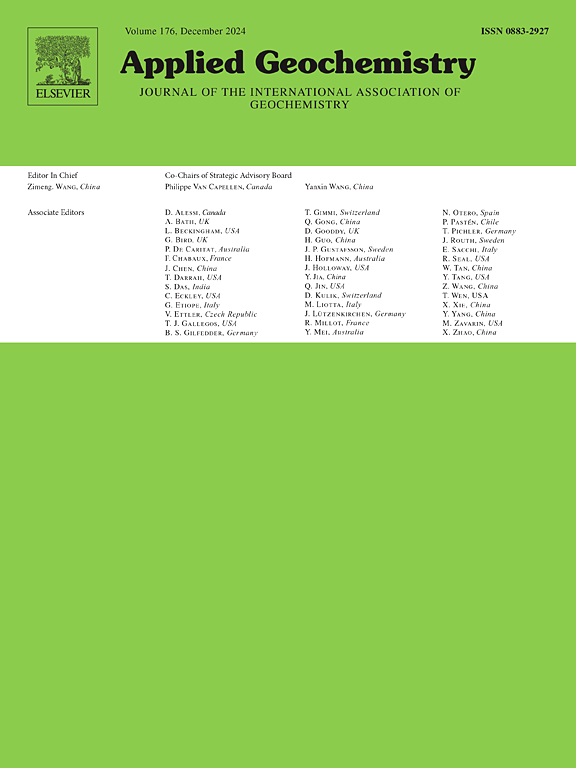The influence of thermo-mineral and seawater on the mineralogy and chemistry of residual smectitic soils from Alentejo, Portugal: a case study
IF 3.4
3区 地球科学
Q1 GEOCHEMISTRY & GEOPHYSICS
引用次数: 0
Abstract
Peloid is a natural product developed during the maturation process between a clay material and water and is used in health and wellness centres due to its mineralogical, physiochemical and biological properties. However, the potential therapeutic value of clays in Portugal has not been fully investigated. Therefore, the main objective of this research is to identify the effects of two mineralized waters: thermo-mineral water (sulphurous and hydroxylated water abundant in chloride ions, sodium and calcium) and seawater, on three residual soils from Alentejo, from a morphological, mineralogical and chemical perspective. The peloids morphology is more homogeneous than the residual soils, and the particle size decreases during the maturation process. Thermo-mineral water enriched the peloids in smectite (58–76 %), while seawater newly formed Na-minerals (decreasing smectite contents to 39–54 %). Smectite is essentially montmorillonite, although there is nontronite and beidelite. The residual soils and peloids have a silicilastic composition (32.23–52.85 %), between 14.22 and 20.53 % of Al2O3, and besides smectite, the mineralogical composition is composed of salts (only in seawater peloids), feldspars, iron oxides, carbonates, and quartz. Morphology and mineralogy enhance the influence of waters in peloids properties and suggest that this samples have potential therapeutic value. Furthermore, physical-chemical, rheological, thermal and biological analysis are needed to support these findings.
热矿物和海水对葡萄牙阿连特茹残余蒙脱土矿物学和化学的影响:一个案例研究
Peloid是在粘土材料和水之间的成熟过程中形成的一种天然产品,由于其矿物学、物理化学和生物特性,被用于保健和保健中心。然而,葡萄牙粘土的潜在治疗价值尚未得到充分研究。因此,本研究的主要目的是从形态学、矿物学和化学角度确定两种矿化水:热矿泉水(含硫和羟基化水,富含氯离子、钠和钙)和海水对阿连特茹三种残留土壤的影响。样粒形态比残积土更均匀,成熟过程中颗粒尺寸减小。热矿泉水富集了蒙脱石的似球粒(58% ~ 76%),而海水新形成的钠矿物(使蒙脱石含量降低至39% ~ 54%)。蒙脱石本质上是蒙脱石,虽然也有非蒙脱石和白脱石。残余土壤和样质体的Al2O3含量在14.22% ~ 20.53%之间,硅酸盐成分(32.23 ~ 52.85%),除蒙脱石外,矿物成分由盐类(仅在海水样质体中)、长石、氧化铁、碳酸盐和石英组成。形态学和矿物学增强了水对类球性质的影响,表明该样品具有潜在的治疗价值。此外,需要物理化学、流变学、热学和生物学分析来支持这些发现。
本文章由计算机程序翻译,如有差异,请以英文原文为准。
求助全文
约1分钟内获得全文
求助全文
来源期刊

Applied Geochemistry
地学-地球化学与地球物理
CiteScore
6.10
自引率
8.80%
发文量
272
审稿时长
65 days
期刊介绍:
Applied Geochemistry is an international journal devoted to publication of original research papers, rapid research communications and selected review papers in geochemistry and urban geochemistry which have some practical application to an aspect of human endeavour, such as the preservation of the environment, health, waste disposal and the search for resources. Papers on applications of inorganic, organic and isotope geochemistry and geochemical processes are therefore welcome provided they meet the main criterion. Spatial and temporal monitoring case studies are only of interest to our international readership if they present new ideas of broad application.
Topics covered include: (1) Environmental geochemistry (including natural and anthropogenic aspects, and protection and remediation strategies); (2) Hydrogeochemistry (surface and groundwater); (3) Medical (urban) geochemistry; (4) The search for energy resources (in particular unconventional oil and gas or emerging metal resources); (5) Energy exploitation (in particular geothermal energy and CCS); (6) Upgrading of energy and mineral resources where there is a direct geochemical application; and (7) Waste disposal, including nuclear waste disposal.
 求助内容:
求助内容: 应助结果提醒方式:
应助结果提醒方式:


